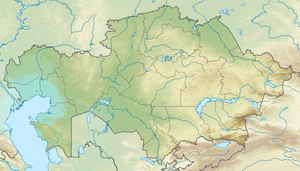Araltobe kurgan
 Reconstruction of Sarmatian chieftain. Araltobe barrow, Kazakhstan, III-II c. BCE. Excavation of Z. Samashev.[1][2] | |
| Coordinates | 47°7′19″N 54°43′4″E / 47.12194°N 54.71778°E |
|---|---|
| Type | Kurgan |
The Araltobe kurgan (Ru: Аралтобе курган) is a burial ground found near Araltobe, Zhylyoi District, in northwestern Kazakhstan, thought to belong to a member of the post-Saka Sarmatian culture, and dated to the 3rd-2nd century BCE.[2][3]
The mound (Zhylyoi "Araltobe" necropolis 1-mound) was excavated in 1999 in the Atyraw region by archaeologists Zeinulla Samashev and Zhumash Dzhetybaeva. They found the remains of a "Golden Man", who presents some parallels with similar "Golden men" found in Issyk kurgan or the kurgan at Shilikty.[2][4]
Long swords with T-shaped pommel and long swords with mushroom-shaped pommel were discovered during the excavation. These are types of "Scythian swords" usually found in the Scythian/Saka kurgans in Central Asia and Eastern Europe, but also known from Sauromations burials as in tumulus no. 3 of the Onaibulak graveyard, tumulus no. 1 and 2 of the Mortik graveyard, or tumulus no. 1 of the Araltobe graveyard.[5]
About 400 gold objects were discovered in the tomb.[3]
-
Bow and arrows from Araltobe barrow
-
Araltobe golden vest (detail)
-
Araltobe kurgan chief
See also
[edit]References
[edit]- ^ Ualikhanova, Aruzhan (22 April 2023). "Archeologists Discover Golden Artifacts in Abai Region's Bozai Burial Ground". The Astana Times.
- ^ a b c Noyanov, Edyl Noyanuly; Yernazar, Sergazy (2016). "THE "GOLDEN PEOPLE" OF KAZAKHSTAN" (PDF). World Science: 46-47.
- ^ a b Andreeva, Petya V. (23 February 2023). "Glittering Bodies: The Politics of Mortuary Self-Fashioning in Eurasian Nomadic Cultures (700 BCE-200 BCE)". Fashion Theory. 27 (2): 10. doi:10.1080/1362704X.2021.1991133. S2CID 240162003.
- ^ Beisenov, Arman (2020). "Tasmola: A Ray of Gold, glittering in the Steppe. Samarkand. 2020". Самарканд: 145.
- ^ Sizdikov, Bagdaulet S.; Seraliyev, Ali A. (26 December 2022). "Swords from Sauromato–Sarmatian Burial Mounds of Western Kazakhstan Analyzed". Oriental Studies. 15 (5): 1110–1125. doi:10.22162/2619-0990-2022-63-5-1110-1125.





